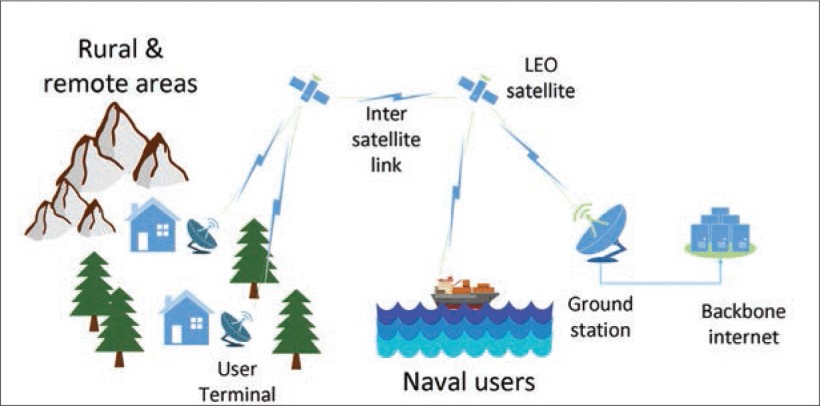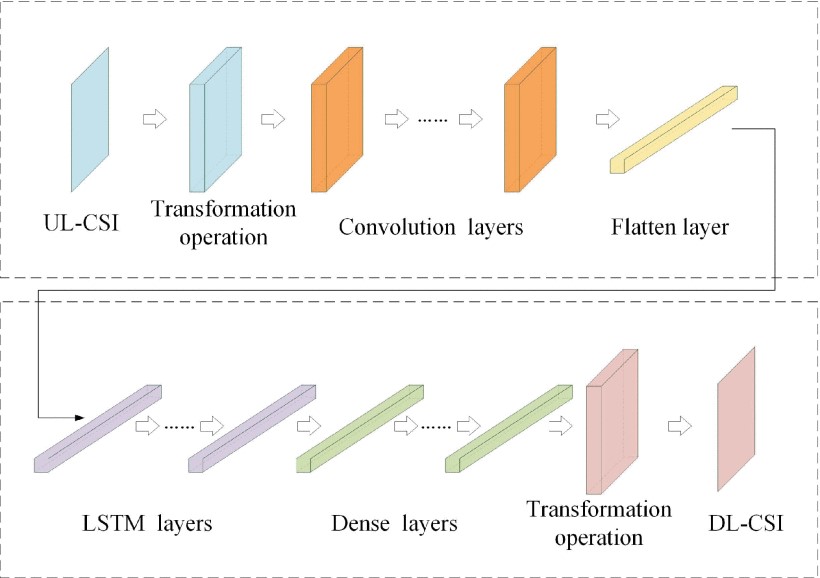热点文献带您关注低轨卫星通信技术的最新进展——图书馆前沿文献专题推荐服务(75)
2022-12-26
 在上一期热点文献推荐中,我们为您推荐了存算一体技术的最新发展前沿,包括三星电子发表的全球首个基于MRAM交叉阵列的存内计算研究,基于阻变存储器RRAM的存算一体芯片,基于三维阻变存储器的存内计算宏芯片,基于集成铁电突触阵列的CMOS兼容存内计算加速器。
在上一期热点文献推荐中,我们为您推荐了存算一体技术的最新发展前沿,包括三星电子发表的全球首个基于MRAM交叉阵列的存内计算研究,基于阻变存储器RRAM的存算一体芯片,基于三维阻变存储器的存内计算宏芯片,基于集成铁电突触阵列的CMOS兼容存内计算加速器。
本期我们为您选取了4篇文献,介绍低轨卫星通信技术的最新发展前沿,包括智能反射表面辅助低轨卫星通信,利用低轨卫星解决加拿大偏远地区宽带接入与数字鸿沟的方案,基于深度学习的低轨卫星大规模MIMO系统信道预测和混合波束赋形,星地量子大气信道的统计验证和深度学习预测,推送给相关领域的科研人员。
文献一 智能反射表面辅助低轨卫星通信
Intelligent Reflecting Surface-Aided LEO Satellite Communication: Cooperative Passive Beamforming and Distributed Channel Estimation
Zheng, Beixiong, etc.
IEEE JOURNAL ON SELECTED AREAS IN COMMUNICATIONS, 2022, 40(10): 3057-3070
Low-earth orbit (LEO) satellite communication plays an important role in assisting/complementing terrestrial communications by providing worldwide coverage, especially in harsh environments such as high seas, mountains, and deserts which are uncovered by terrestrial networks. Traditionally, the passive reflect-array with fixed phase shifts has been applied in satellite communications to compensate for the high path loss due to long propagation distance with low-cost directional beamforming; however, it is unable to flexibly adapt the beamforming direction to dynamic channel conditions. In view of this, we consider in this paper a new intelligent reflecting surface (IRS)-aided LEO satellite communication system, by utilizing the controllable phase shifts of massive passive reflecting elements to achieve flexible beamforming, which copes with the time-varying channel between the high-mobility satellite (SAT) and ground node (GN) cost-effectively. In particular, we propose a new architecture for IRS-aided LEO satellite communication where IRSs are deployed at both sides of the SAT and GN, and study their cooperative passive beamforming (CPB) design over line-of-sight (LoS)-dominant single-reflection and double-reflection channels. Specifically, we jointly optimize the active transmit/receive beamforming at the SAT/GN as well as the CPB at two-sided IRSs to maximize the overall channel gain from the SAT to each GN. Interestingly, we show that under LoS channel conditions, the high-dimensional SAT-GN channel can be decomposed into the outer product of two low-dimensional vectors. By exploiting the decomposed SAT-GN channel, we decouple the original beamforming optimization problem into two simpler subproblems corresponding to the SAT and GN sides, respectively, which are both solved in closed-form. Furthermore, we propose an efficient transmission protocol to conduct channel estimation and beam tracking, which only requires independent processing of the SAT and GN in a distributed manner, thus substantially reducing the implementation complexity. Simulation results validate the performance advantages of the proposed IRS-aided LEO satellite communication system with two-sided cooperative IRSs, as compared to various baseline schemes such as the conventional reflect-array and one-sided IRS.
阅读原文:
https://ieeexplore.ieee.org/document/9849035
 An illustration of the LEO satellite communication with two-sided cooperative IRSs
An illustration of the LEO satellite communication with two-sided cooperative IRSs
文献二 利用低轨卫星解决加拿大偏远地区宽带接入与数字鸿沟的方案
The Digital Divide in Canada and the Role of LEO Satellites in Bridging the Gap
Ahmmed, Tuheen, etc.
IEEE COMMUNICATIONS MAGAZINE, 2022, 60(6): 24-30
Overcoming the digital divide in rural and remote areas has always been a big challenge for Canada with its huge geographical area. In 2016, the Canadian Radio-television and Telecommunications Commission announced broadband Internet as a basic service available for all Canadians. However, approximately one million Canadians still did not have access to broadband services as of 2020. The COVID-19 pandemic has made the situation more challenging, as social, economic, and educational activities have increasingly been transferred online. The condition is more unfavorable for Indigenous communities. A key challenge in deploying rural and remote broadband Internet is to plan and implement high-capacity backbones, which are now available only in denser urban areas. For any Internet provider, it is almost impossible to make a viable business proposal in these areas. For example, the vast land of the Northwest Territories', Yukon's, and Nunavut's diverse geographical features present obstacles for broadband infrastructure. In this article, we investigate the digital divide in Canada with a focus on rural and remote areas. In so doing, we highlight two potential solutions using low Earth orbit (LEO) constellations to deliver broadband Internet in rural and remote areas to address the access inequality and the digital divide. The first solution involves integrating LEO constellations as a backbone for the existing 4G/5G telecommunications network. This solution uses satellites in a LEO constellation to provide a backhaul network connecting the 4G/5G access network to its core network. The 3rd Generation Partnership Project already specifies how to integrate LEO satellite networks into the 4G/5G network, and the Canadian satellite operator Telesat has already showcased this solution with one terrestrial operator, TIM Brasil, in their 4G network. In this way, users can seamlessly access broadband Internet via their mobile terminals. The second solution is based on the direct use of LEO constellations, such as Starlink, which are now operating in Canada, to deliver broadband Internet. As LEO satellites fly lower, their round-trip latency is lower, and the user terminals can receive Internet signals as long as they are pointing at the sky. An in-depth discussion of both solutions is presented in this work.
阅读原文:
https://ieeexplore.ieee.org/document/9800119
 Starlink's LEO satellites beaming internet signals toward user terminals directly to provide broadband internet in rural and remote areas
Starlink's LEO satellites beaming internet signals toward user terminals directly to provide broadband internet in rural and remote areas
文献三 基于深度学习的低轨卫星mMIMO系统信道预测和混合波束赋形
Deep Learning (DL)-Based Channel Prediction and Hybrid Beamforming for LEO Satellite Massive MIMO System
Zhang, Yunyang, etc.
IEEE INTERNET OF THINGS JOURNAL, 2022, 9(23): 23705 - 23715
Low-Earth orbit (LEO) satellites are recognized as one of the most promising infrastructures for realizing global Internet of Things (IoT) services. With the explosive growth of user terminals (UTs) and data traffic, the integration of massive multiple-input multiple-output (mMIMO) techniques and LEO satellite communication systems has been regarded as a novel idea to enhance system capacity and realize global seamless high-speed interconnection. However, obtaining effective downlink channel state information (CSI) and establishing a simple and efficient hybrid beamforming mechanism are challenging tasks due to the limitations of objective factors, such as high dynamic, long delay, and low payload in LEO satellite scenarios. It is embodied in three aspects: 1) the untenable channel reciprocity in time division duplex (TDD) systems; 2) the training feedback costs and feedback delay in frequency division duplex (FDD) systems; and 3) the complex nonconvex optimization process faced by hybrid beamforming design. Driven by the performance advantages of the deep learning (DL) technology to deal with various problems in the field of physical layer communications, this article proposes to use a deep neural network (DNN) to solve the above challenges, and constructs SatCP and SatHB schemes for realizing downlink CSI acquirement and hybrid beamforming design, respectively. By deeply mining the potential correlation of the uplink-downlink channels between LEO satellites and UTs and exploring the mapping relationship between CSI and beamformers, the SatCP can assist LEO satellites to directly predict the future downlink CSI based on the observed uplink CSI with no need for downlink channel estimation, while the SatHB can easily generate the corresponding beamformers based on the downlink CSI predicted by the SatCP without requiring complex optimization. Numerical results demonstrate that the proposed SatCP and SatHB can play an effective auxiliary role in LEO satellite mMIMO communication systems.
阅读原文:
https://ieeexplore.ieee.org/document/9826890
 Architecture of the SatCP
Architecture of the SatCP
 Architecture of the SatHB
Architecture of the SatHB
文献四 星地量子大气信道的统计验证和深度学习预测
Statistical verifications and deep-learning predictions for satellite-to-ground quantum atmospheric channels
Trinh, Phuc, V, etc.
COMMUNICATIONS PHYSICS, 2022, 5(1): 504-512
Laser communications from small satellite platforms empowers the establishment of quantum key distribution (QKD), relying on quantum superposition states of single photons to realize unconditional security between distant parties at a global scale. Although recent breakthrough experiments have demonstrated the feasibility of satellite-to-ground QKD links, the underlying statistical characteristics of quantum atmospheric channels have not been well-understood and experimentally verified in the literature. In this paper, we highlight that classical atmospheric statistical models can be applied for describing random fluctuations of the quantum channels. To verify this fact, we report a statistical verification study of quantum atmospheric channels from the world's first low-Earth orbit (LEO) 50-kg-class microsatellite-to-ground quantum-limited communication experiment. The verified statistical model is then applied to numerically investigate the quantum bit-error rate (QBER) and secret-key length (SKL) of a decoy-state efficient Bennett-Brassard 1984 (BB84) QKD protocol with optimized parameters considering finite-key effects, implemented over a LEO 6-unit (6U)-CubeSat-to-ground link. Important insights of the physical channel effects including pointing errors and atmospheric turbulence on the QBER and SKL are then revealed. Finally, we present a study using a deep-learning-based long short-term memory (LSTM) recurrent neural network (RNN) for predicting photon-count fluctuations over quantum atmospheric channels.
阅读原文:https://www.nature.com/articles/s42005-022-01002-1
 Physical channel characteristics and losses of the considered LEO satellite pass
Physical channel characteristics and losses of the considered LEO satellite pass
往期精彩推荐
热点文献带您关注AI深度学习与计算机视觉——图书馆前沿文献专题推荐服务(33)
热点论文与带您领略未来通信的热点技术及最新进展——图书馆前沿文献专题推荐服务(34)
热点文献带您关注AI强化学习——图书馆前沿文献专题推荐服务(35)
热点论文与带您领略5G/6G基础研究的最新进展——图书馆前沿文献专题推荐服务(36)
热点文献带您关注AI与边缘计算——图书馆前沿文献专题推荐服务(37)
热点论文与带您领略5G/6G领域热点研究的最新进展——图书馆前沿文献专题推荐服务(38)
热点文献带您关注AI技术的最新进展——图书馆前沿文献专题推荐服务(39)
热点论文与带您领略5G相关领域研究的最新进展——图书馆前沿文献专题推荐服务(40)
热点文献带您关注AI视觉跟踪——图书馆前沿文献专题推荐服务(41)
热点论文带您领略未来通信在海空领域研究的最新进展——图书馆前沿文献专题推荐服务(42)
热点文献带您关注AI与医学研究——图书馆前沿文献专题推荐服务(43)
热点论文带您领略未来通信在材料领域研究的最新进展——图书馆前沿文献专题推荐服务(44)
热点文献带您关注AI与医学图像——图书馆前沿文献专题推荐服务(45)
热点论文带您领略未来通信在光电材料及信息编码领域的最新进展——图书馆前沿文献专题推荐服务(46)
热点文献带您关注AI与生物学——图书馆前沿文献专题推荐服务(47)
热点论文带您领略未来通信在新材料技术领域的最新进展——图书馆前沿文献专题推荐服务(48)
热点文献带您关注AI与人脸识别——图书馆前沿文献专题推荐服务(49)
热点论文带您领略光电半导体领域的最新进展——图书馆前沿文献专题推荐服务(50)
热点文献带您关注AI在集成电路领域的最新进展——图书馆前沿文献专题推荐服务(51)
热点论文带您领略半导体领域的最新进展——图书馆前沿文献专题推荐服务(52)
热点文献带您关注AI在光神经网络领域的最新进展——图书馆前沿文献专题推荐服务(53)
热点论文带您领略未来通信在新材料技术领域的最新进展——图书馆前沿文献专题推荐服务(54)
热点文献带您关注AI深度神经网络的最新进展——图书馆前沿文献专题推荐服务(55)
热点论文带您领略新材料半导体领域的最新进展——图书馆前沿文献专题推荐服务(56)
热点文献带您关注AI视频动作识别的最新进展——图书馆前沿文献专题推荐服务(57)
热点论文带您领略未来通信热点技术的最新进展——图书馆前沿文献专题推荐服务(58)
热点文献带您关注AI深度学习的最新进展——图书馆前沿文献专题推荐服务(59)
热点论文带您领略未来通信研究热点的最新进展——图书馆前沿文献专题推荐服务(60)
热点文献带您关注AI领域的最新进展——图书馆前沿文献专题推荐服务(61)
热点论文带您探索智能化以及超表面在未来通信中的应用——图书馆前沿文献专题推荐服务(62)
热点文献带您关注AI领域的最新进展——图书馆前沿文献专题推荐服务(63)
热点论文带您领略半导体领域的最新进展——图书馆前沿文献专题推荐服务(64)
热点文献带您关注AI领域的最新进展——图书馆前沿文献专题推荐服务(65)
热点论文带您探索新型网络架构以及超表面在未来通信中的应用——图书馆前沿文献专题推荐服务(66)
热点文献带您关注AI深度强化学习的最新进展——图书馆前沿文献专题推荐服务(67)
热点论文带您探索新型网络架构以及超材料在未来通信中的应用——图书馆前沿文献专题推荐服务(68)
热点文献带您关注AI图神经网络的最新进展——图书馆前沿文献专题推荐服务(69)
热点论文带您探索未来网络中使用的新材料以及相关技术 ——图书馆前沿文献专题推荐服务(70)
热点文献带您关注AI的最新进展——图书馆前沿文献专题推荐服务(71)
热点文献带您关注电子皮肤的最新进展——图书馆前沿文献专题推荐服务(72)
热点文献带您关注存算一体技术的最新进展——图书馆前沿文献专题推荐服务(73)
热点文献带您关注惯性测量单元的最新进展——图书馆前沿文献专题推荐服务(74)





